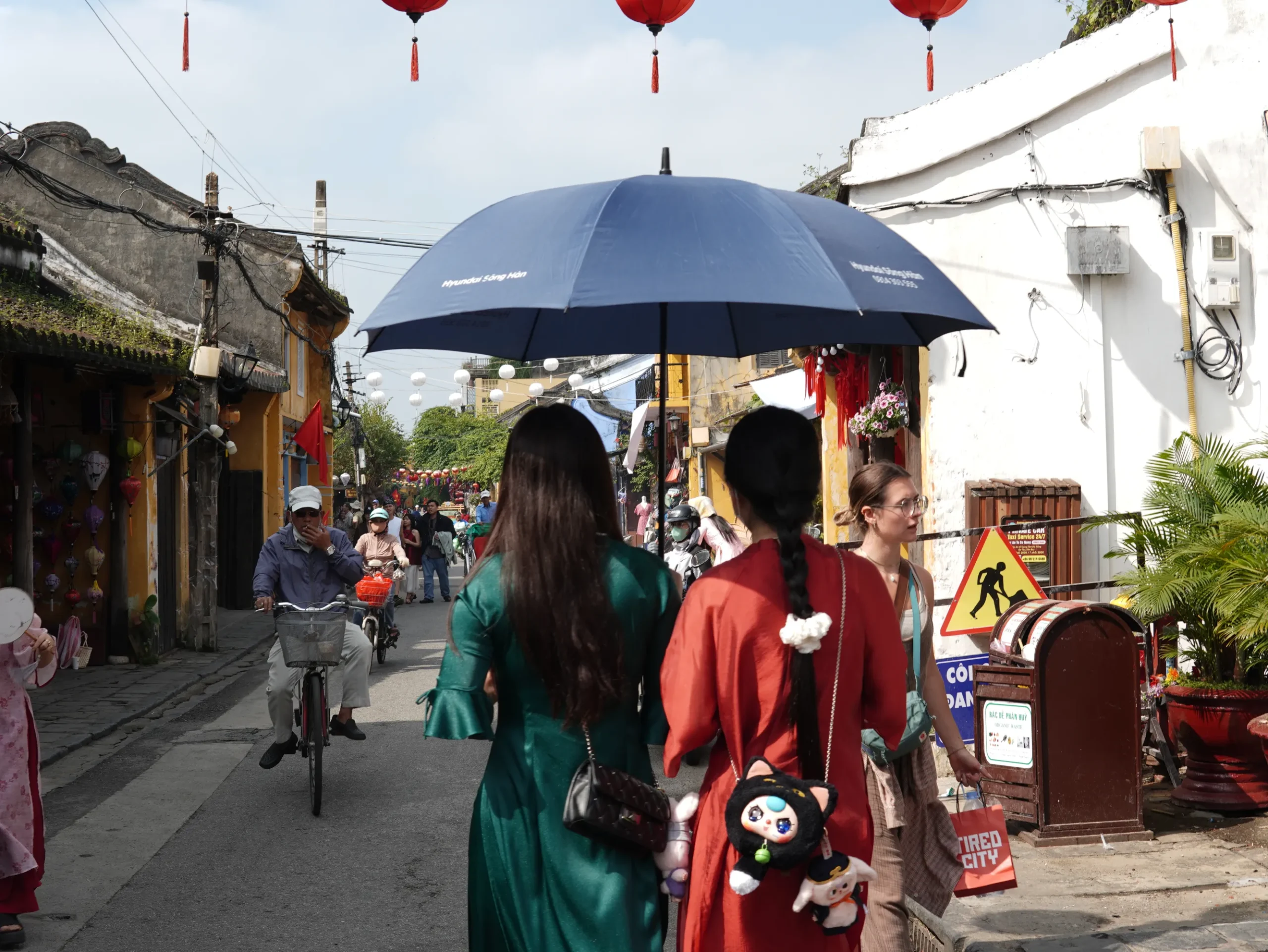Is Hoi An worth visiting?
One quick Google search about Hoi An will leave you more confused than informed. Half the reviews scream “unmissable UNESCO gem with incredible countryside!” while the other half warn “ancient town that’s been Disneyland-ified for tourists”. Reddit threads turn into battlegrounds between people who found magic in morning bike rides through rice paddies and those who left after one day, frustrated by crowds and inflated prices.

As someone who’s Vietnamese and has watched Hoi An transform over the past decade, I’ll be honest: both sides are right. Hoi An can absolutely be a tourist trap if you approach it wrong. But dismissing Hoi An entirely because of these issues means missing something genuinely special that still exists here – you just have to know where to look and when to look for it. After reading dozens of Hoi An travel guides that dance around the awkward realities, I realized what’s missing: honest answers to the questions people actually worry about but don’t know who to ask. Let’s address these concerns first!
Q: Is Hoi An worth visiting or just skip it entirely?
Don’t skip Hoi An just because it’s crowded. Yes, it’s touristy, it’s literally well known as a sight to see. What makes Hoi An special isn’t just the Instagram-famous yellow walls and lanterns; it’s the living 400-year history where Chinese, Japanese, French, and Vietnamese cultures have genuinely blended into something that exists nowhere else in Vietnam. Treating Hoi An like a checkbox destination means missing everything that makes it genuinely special.
Q: How bad are the crowds really?
The crowds are predictable and geographically concentrated. Early morning (before 8 AM) and late evening (after 8PM) in the Ancient Town are completely different experiences. And 10 minutes by bicycle in any direction from the center, you’re in quiet residential areas where life proceeds normally.
Q: Is Hoi An full moon lantern festival worth planning my trip around?
A: Honestly? No. The full moon festival gets all the hype, but it’s mostly marketing. The crowds are absolutely overwhelming, we’re talking shoulder-to-shoulder packed streets where moving becomes difficult. Regular evenings in Hoi An are already magical with lanterns lit every night. The crowd peaks around 6-7 PM, then thins out significantly after 9PM. If you want the lantern experience without the chaos, visit any evening after 9PM—you’ll get beautiful photos, peaceful atmosphere, and actually be able to walk the streets normally.

Q: How do I avoid typical Hoi An tourist mistakes?
A: The biggest Hoi An tourist mistake is cramming everything into midday when it’s hottest, the summer here is brutal, even for us. Locals structure their days around heat and crowds—early morning activity, afternoon rest, evening exploration.
Q: Is bargaining expected in Hoi An? How aggressive should I be with Hoi An prices?
A: In Hoi An markets and with street vendors, yes—initial prices can be inflated 2-3 times actual value. In Hoi An markets, “the price initially called can be safely reduced by three times and eventually agreed to half price.” But in Hoi An restaurants, cafes, and established shops with fixed prices, bargaining isn’t expected and can be offensive.
Q: How pushy are the vendors really, and how do I deal with them?
A: In some parts of Ancient Town, they can be genuinely annoying – grabbing your arm to get attention, refusing to take “no” for an answer. It’s jarring if you’re not expecting it and completely unlike the rest of Vietnam’s generally polite culture.
Be polite but firm. “Không, cảm ơn” (no, thank you) works better than English. Don’t feel guilty about being direct—locals are direct with pushy vendors too. Once you’re 100 meters outside the tourist core, vendor behavior returns to normal Vietnamese politeness.
Q: Should I tip in Hoi An restaurants and tours? What’s the tipping culture in Vietnam?
A: Vietnam has no traditional tipping culture, tip when you feel generous or receive lovely service, bad weather Grab rides/Grab Food delivery, exceptional experiences, genuinely kind treatment. If you don’t feel like tipping, don’t. The key is tipping should come from your genuine appreciation, never from guilt or demands.
Q: Should I stay in the Ancient Town or outside it?
Hoi An is a compact town with just a 6km radius, and with Grab available everywhere, there’s absolutely no need to stay in the Old Quarter. The whole area is flat and bikeable and most hotel provides free bicycles. Plus, you’ll appreciate the Ancient Town more when visiting it becomes a deliberate choice rather than just stepping outside your hotel.

Hoi An Transportation Guide: Distances, Costs, and Best Travel Options
Getting around central Vietnam can be confusing with multiple transport options and varying prices. Here’s the practical breakdown of distances, travel times, and costs for the most common routes from Hoi An.
Hoi An to Da Nang Distance and Transport Options
- Distance: 28-30km
- Travel time: 30-40 minutes by car
Hoi An Transport Options and Costs (Updated 2025)
Private taxi (arranged in advance): 250,000 VND (~$10 USD)
- Best value for this route
- Fixed price, no surge pricing
- Can arrange pickup through your hotel
Grab Car: 300,000-400,000 VND (~$12-16 USD)
- Price varies by time of day and demand
- Convenient app booking
- Higher cost but more flexible timing
Grab Bike: 130,000 VND (~$5.50 USD)
- Cheapest option
- Only suitable with minimal luggage
- Weather dependent
Da Nang Airport Transportation
Distance from Da Nang city center: 2-6km (depending on your location)
Travel time: 10-15 minutes
The short Da Nang airport distance makes it one of Vietnam’s most convenient airports. Most Da Nang hotels are within 6km of the airport, making taxi costs reasonable for final-day logistics.
Hoi An to Da Nang Airport Direct
Distance: 28km
Travel time: 30-40 minutes
Cost: Similar to Hoi An-Da Nang city prices (250,000-400,000 VND depending on transport choice)
Many travelers go directly from Hoi An to Da Nang Airport without stopping in Da Nang city. The distance and travel time are nearly identical to the Hoi An-Da Nang city route.
Hoi An to Hue Distance and Options
Distance: 120 kilometers
Travel time: 3-4 hours by car or bus
The Hoi An to Hue distance makes this a longer journey requiring more planning. Options include:
Private car/taxi: Most comfortable but expensive Tourist bus: Mid-range option with several daily departures
Local bus: Cheapest but longest travel time Train via Da Nang: Take transport to Da Nang, then catch train to Hue
Hue via Da Nang Train Option
Many travelers find the Da Nang to Hue train route scenic and comfortable. The process:
- Travel Hoi An to Da Nang (30-40 minutes)
- Take train from Da Nang to Hue (2.5-3 hours)
- Total journey time: 3.5-4 hours including connections
This route offers better scenery than direct bus travel and is often more comfortable for the longer Hoi An to Hue distance.
Beyond the Postcard: What Hoi An Actually Offers
Hoi An reveals itself in two distinct layers. The Ancient Town is pure history, a pedestrianized time capsule where countless cafes, restaurants, shops, tailors and boutique hotels occupy buildings that have stood for centuries. This is where you’ll wander the streets admiring historic architecture, visiting the Fujian Assembly Hall, exploring merchant houses like Tan Ky and Phung Hung, and discovering the small museums that chronicle the multicultural trading heritage. It’s tourist-packed (arrive early for peace), but authentically preserved – a living piece of Vietnam’s past.
Step outside this historic core, and you encounter modern Vietnamese life in full swing. Cycle through neighborhoods like Cam Thanh Village or cross the river to Cam Kim Island, and you’re back in the countryside of Vietnam – local markets, residential streets, workshops where traditional crafts continue not for tourists but for local demand. This is where Hoi An stops being a heritage site and becomes a working town.
The beaches tell the same story. Cua Dai and An Bang are the developed stretches where beach clubs and resorts cater to visitors. But venture to either side of these main beaches, and you’ll find virtually empty coastline – just local fishing boats, a few Vietnamese families, and stretches of sand that feel worlds away from the historic town’s crowds. It’s this contrast—preserved history in the center, authentic modern life in the neighborhoods, untouched nature at the edges—that gives Hoi An its unique appeal.

Money and Practical Survival Guide
Cash is absolutely king: Don’t rely on cards anywhere outside major hotels and upscale restaurants. Get Vietnamese dong from ATMs. Keep small bills; many vendors can’t break 500,000 VND notes.
Internet and navigation: Get a local SIM card immediately—your hotel can usually arrange an ITEL card setup. You’ll need it constantly for Grab rides, Google Translate, maps, and finding activity hosts. Download offline maps as backup.
Transport reality: Grab is Vietnam’s Uber and works perfectly in Hoi An. Much more reliable than trying to negotiate with random motorbike drivers.
Real cost breakdown (2025 prices):
- Bánh mì from street vendor: 20,000 – 30,000 VND
- Full local lunch (chicken rice + drink): 80,000 – 100,000 VND
- Nice dinner at a restaurant: 200,000-400,000 VND (one person)
- Half-day tours/activities: 400,000 – 850,000 VND
- Bicycle rental: 50,000 VND per day (for city bike) & around 300,000 VND (mountaint bike)
- Rain poncho (essential): 10,000 – 20,000 VND






